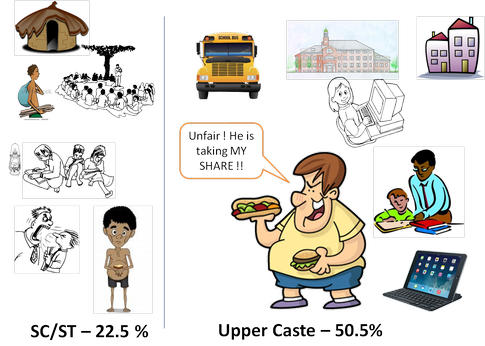
Reservations: For Whom And For What?
The brewing Kapu agitation and the recent Hardik Patel led the agitation for BC (Backward Class) status for Patidars (Patels) in Gujarat has reignited passions and stirred up debates about reservations again. The word “reservation” is a very charged term and evokes strong emotions in the country.
It typically refers to constitutionally guaranteed protections and preferential treatment given to historically oppressed sections of the society – Dalits (Scheduled castes i.e. SCs), tribals (STs) and ‘BCs’.
The idea of such reservations is to help create a modicum of equal opportunity in the overwhelmingly unequal Indian society. Anybody with a rational, historical understanding of Hindu caste system should recognize that the classes that enjoy the true ‘reservations’ are not the SCs, STs and BCs but the upper castes and the well-to-do Sudhras with thousands of years of ‘reserved’ access to land, wealth and exclusive control of every aspect of economy and Hindu society.
Those hereditary rights guaranteed by Manuvadi system have assured their continued hegemony into the 21st century.
The concepts of government, jobs and inclusivity in British India led to the idea of bringing the hitherto ignored sections into the ‘mainstream’.
Reservations to oppressed castes were subsequently first introduced in British India in the background of movements organized by Jyothirao Phule, Periyar, etc. and also espoused strongly in princely states such as Travancore and Kolhapur (Shahu Maharaja, the real Chatrapathi).
The year 1933 marked a flashpoint in the history of caste-based reservations when the British government introduced the Communal Award with separate electorates for Muslims, Christians, Sikhs and more importantly, Dalits. Ambedkar supported this but the ‘father’ of the nation (Gandhi) vociferously opposed it.
Eventually, Ambedkar had to concede to Gandhi’s blackmail and Dalits remained under the Hindu fold albeit with reserved seats within. Following the adoption of the constitution in post-independent India, reservations to SCs, STs were formalized. OBC reservations were haphazardly implemented later on.
The 1953 Kalelkar Commission and the 1980 Mandal Commission reports came up with the suggestion of 70% and 52% reservations for OBCs respectively but the ultimate number was set at 27% in 1992 following a court verdict a few years after the nation witnessed bloody street violence with anti-reservation sentiments touching a chord with the upper caste youth. Even this 27% reservation is not rightfully implemented in several sectors with a report in 2010 showing that only 7% of civil service positions in the country were filled with OBCs.
Reservations are certainly a great tool of affirmative action that has helped scores of Dalit, tribal and BC families leap out of poverty. However, for every educated Dalit, tribal or OBC, there appear to be a million others who don’t even make the cut to qualify for these reservations.
Thus, reservations are only one mode of support and rather an imperfect means to the end goal i.e. decimation of caste structure. True social reform is only feasible with a much deeper cleansing of the Hindu society which appears almost impossible today. How many centuries of reservations can counteract the economic power that is concentrated in the upper castes today across India?
How many Dalit entrepreneurs will it take to match the clout enjoyed by Kamma industrialists, reddy landlords, etc, etc? Why is a Rahul Gandhi or a Brahminized Narendra Modi (does it really matter if he is theoretically a BC?) a readily acceptable PM candidate but not a Mayawati or Lalu Yadav?
Getting back to the question of reservations: with the ruthless embrace of capitalism and liberalization that took birth in the 1990s, the relevance of reservations in the government sector is rapidly diminishing.
With successive governments (both right and left-leaning) competing in cutting public sector jobs, the upper caste youth quickly realized that there is no point in spending their energies in anti-reservation movements. The governments themselves, which had no sincerity in implementing the reservations in letter and spirit anyway have found an ally in capitalism in gleefully scuttling the scope of reservations.
As Arundhati Roy stated, Capitalism + Casteism = a toxic alloy.
Yet, demands from groups such as Patels, Kapus and Gujjars seem to be still cropping up in this era. The reason is that the profoundly pro-market approaches taken by the central and state governments across the country have failed to satisfy the hunger for jobs and livelihood even among the traditionally upper caste groups.
The rural and semi-urban youth from such castes seem to be increasingly alienated from the mainstream. Thus, the politically adept groups among such upper castes are channeling their energies in seeking ‘backward’ or even ‘tribal’ status. They have come to see reservations as a means to satisfy their goals.
But, their penchant, in most cases, arises from their ire and misplaced conception that the OBCs, SCs and STs are getting ‘ahead’ of them.
Ironically, while demanding reservations, they still stick to their ‘upper’ caste roots and refuse to socially intermingle with the ‘lower’ castes. Thus, as is true in most cases in India, they refuse to acknowledge true history but want to reap the benefits that are intended for the oppressed.
Oppressors now want the fruits of the oppressed!
But the mulnivasis will have to be selective and shrewd in their approach towards these agitations. In some instances, political expediency may in fact take us closer to the goal of clinching real political power while sticking to Ambedkarite philosophy and ideals.
Mutually beneficial alliances can in fact dethrone entrenched powerhouses in states like Andhra Pradesh that have recently swallowed our hero Rohith Vemula with their Manuwadi underpinnings.
Author – Nijam Gara




+ There are no comments
Add yours